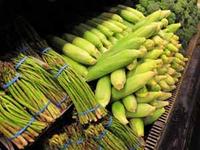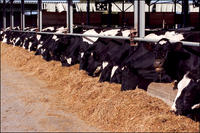-
Biosecurity paramount to ensure Australia retrains healthy agricultural output
Experts at the State Biosecurity Forum, held ten days ago in Australia, recommend strong partnerships and global strategies to secure protection of present and future agriculture for Western Australia (WA); the participants at the event discussed issues ranging from the effects of climate change and UV radiation on biosecurity to the implementation of computer modeling in agricultural policy making decisions
-
-
Intensive farming with a climate-friendly touch
In the world of agriculture, climate protection and intensive farming are generally assumed to be a contradiction in terms; scientists have come up with a new land development concept that could change this view; the new model is tailored to medium-sized farms in South America and sees farmers transitioning from large-scale monoculture to more diverse crop mixtures spread over smaller plots interspersed with wooded areas — a switch that can bring significant financial benefits
-
-
Indian monsoon failure more frequent with warming
Global warming could cause frequent and severe failures of the Indian summer monsoon in the next two centuries, new research suggests; the effects of these unprecedented changes would be extremely detrimental to India’s economy which relies heavily on the monsoon season to bring fresh water to the farmlands
-
-
China’s Mekong River dams undermine neighbors’ economies, food production

Five Chinese dams on the Mekong River’s upper portions have caused rapid changes in water level, and other adverse effects, downstream, especially in Vietnam, Cambodia, Thailand, and Laos, where millions of people rely on the river for water, food, and transportation
-
-
Cutting food losses in half would feed an additional billion people
More efficient use of the food production chain and a decrease in the amount of food losses will dramatically help maintaining the planet’s natural resources and improve people’s lives; researchers have proved a valid estimation, for the first time, for how many people could be fed with reducing food losses
-
-
Herbicide-resistant crops require more herbicides
Researchers find that the use of herbicides in the production of three genetically modified herbicide-tolerant crops — cotton, soybeans, and corn — has actually increased; this counterintuitive finding is based on an exhaustive analysis of publicly available data from the U.S. Department of Agriculture’s National Agriculture Statistics Service
-
-
Probability maps help detect food contamination

Researchers demonstrate how developing a probability map of the food supply network using stochastic network representation might shorten the time it takes to track down contaminated food sources; stochastic mapping shows what is known about how product flows through the distribution supply chain and provides a means to express all the uncertainties in potential supplier-customer relationships that persist due to incomplete information
-
-
How vulnerable is the U.S. to agro-terror attack?

Since the 9/11 terrorist attacks, the United States has spent billions of dollars to make the country safer from another catastrophic event, but little of that money, and little attention, have been directed toward preventing, coping with, and recovering from a terrorist agro-attack; how vulnerable is the United States to an attack on its food system?
-
-
Precision agriculture using military technology: drones
Drones are military aircraft currently being repurposed for everyday use, especially within the growing field of precision agriculture; these flying robots allow farmers to detect changes in water content, plant health, and pesticide dispersal in their fields
-
-
Regional, global food security effects of climate change to felt soon
Research shows that within the next ten years large parts of Asia can expect increased risk of more severe droughts, which will impact regional and possibly even global food security; on average, across Asia, droughts lasting longer than three months will be more than twice as severe in terms of their soil moisture deficit compared to the 1990-2005 period; China, Pakistan, and Turkey as the most seriously affected major producers of wheat and maize
-
-
Rinderpest: how the world’s deadliest cattle plague was eradicated
Rinderpest, the deadliest of cattle diseases, was declared vanquished in May 2011; after smallpox, it is only the second disease (and first livestock disease) ever to be eradicated from the earth; the insights gained from the eradication campaign may be applied to similar diseases that today ravage the livestock populations on which the livelihoods of one billion of the world’s poor depend; the lessons could also be applied to “zoonotic” diseases which are responsible for 2.4 billion cases of human illness and 2.2 million deaths per year
-
-
Smart agriculture will increase global food production, reduce environmental impact

Global demand for food is expected to double by 2050 due to population growth and increased standards of living; a new study, based on analysis of agricultural data gathered from around the world, offers hope that with more strategic use of fertilizer and water, we could not only dramatically boost global crop yield, but also reduce the adverse environmental impact of agriculture
-
-
Antibiotic residues in sausage meat may promote pathogen survival

Antibiotic residues in uncured pepperoni or salami meat are potent enough to weaken helpful bacteria that processors add to acidify the sausage to make it safe for consumption; sausage manufacturers commonly inoculate sausage meat with lactic-acid-producing bacteria; by killing the bacteria that produce lactic acid, antibiotic residues can allow pathogenic bacteria to proliferate
-
-
No-till could help stabilize crop yields despite climate change
Reducing tillage for some Central Great Plains crops could help conserve water and reduce losses caused by climate change, according to studies at the U.S. Department of Agriculture
-
-
China’s food production characterized by corruption, health-threatening practices

A report on Chinese TV showed rotten peaches spiked with sodium metabisulfite to make the fruit look fresh, seasoned in bleaching agents and additives harmful to the human liver and kidneys, and pickled in outdoor pools surrounded by garbage; the peaches are then packed in dirty bags which were previously used to hold animal feed, and shipped off to big brand stores; trouble is, this story is typical of, rather than an exception to, food production practices in China
-
- All
- Regional
- Water
- Biometrics
- Borders/Immig
- Business
- Cybersecurity
- Detection
- Disasters
- Government
- Infrastructure
- International
- Public health
- Public Safety
- Communication interoperabillity
- Emergency services
- Emergency medical services
- Fire
- First response
- IEDs
- Law Enforcement
- Law Enforcement Technology
- Military technology
- Nonlethal weapons
- Nuclear weapons
- Personal protection equipment
- Police
- Notification /alert systems
- Situational awareness
- Weapons systems
- Sci-Tech
- Sector Reports
- Surveillance
- Transportation
Advertising & Marketing: advertise@newswirepubs.com
Editorial: editor@newswirepubs.com
General: info@newswirepubs.com
2010-2011 © News Wire Publications, LLC News Wire Publications, LLC
220 Old Country Road | Suite 200 | Mineola | New York | 11501
Permissions and Policies
Editorial: editor@newswirepubs.com
General: info@newswirepubs.com
2010-2011 © News Wire Publications, LLC News Wire Publications, LLC
220 Old Country Road | Suite 200 | Mineola | New York | 11501
Permissions and Policies
